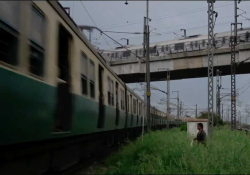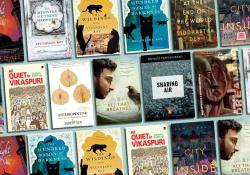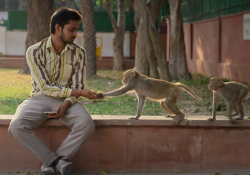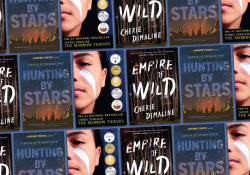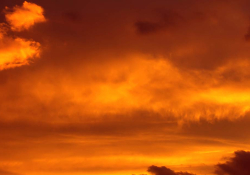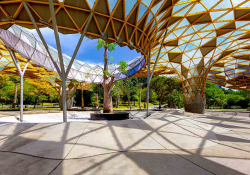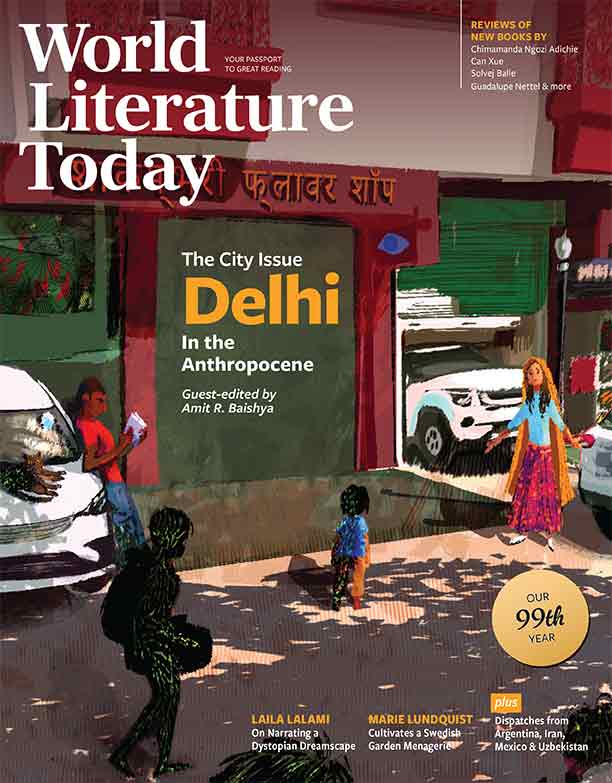Introduction

It is a truth universally acknowledged that Bombay is the spiritual home for Indian writing in English. Delhi, however, is the emerging home for explorations of the Anthropocene in Indian English literature. Consider, for instance, two recent novels that are based wholly or in part in Delhi. Arundhati Roy’s The Ministry of Utmost Happiness (2017) begins with a scene of vulture disappearance in Delhi—vultures disappeared primarily due to diclofenac poisoning. Diclofenac is used to increase dairy production. The neoliberal reduction of sentient bovine bodies into commodified milk-machines leads directly to avian death as diclofenac functions like “nerve-gas” for vultures. From species death we move to a vibrant depiction of multispecies life in an abandoned Old Delhi graveyard as the novel attempts “becoming everybody” and “becoming everything.” Nilanjana Roy’s Wildings duology—The Wildings (2012) and The Hundred Names of Darkness (2013)—explores the gradual erasure of syncretic cultures in the Nizamuddin area of New Delhi, the location of the dargah of the Sufi saint, Nizamuddin Auliya, venerated by Muslims and Hindus. Significantly, Roy’s duology is narrated through the viewpoints of a clowder of free-ranging cats. Cats are ubiquitous presences in the dargah and a sacralized animal in Islamic tradition. While the duology is an elegy for disappearing Islamic and Sufi-influenced practices and traditions in Delhi, it simultaneously depicts the impact of neoliberal processes on feline habitations. Older constructions with sloping roofs where cats used to wander make way for high-rises and gated communities in the current day. The Bigfeet (humans) “who lived in the towering new buildings had no liking at all for cats and dogs and other small creatures.”
This special issue on “Delhi in the Anthropocene” considers the burgeoning oeuvre of post–2010 anglophone literature and multispecies cinema on the impacts of the Anthropocene and of accelerating neoliberal processes in India’s capital city. We also feature select photographs by Ravi Agarwal, who has written eloquently elsewhere about “nonplaces” in the Anthropocene in Delhi like the Bhalswa landfill. The hosting of the Commonwealth Games in Delhi in 2010—a year that serves as the provisional baseline for this survey—led to massive population displacements and infrastructural changes that impacted urban spatial configurations, the fundamental elements of life and living (air, water, temperature), and multispecies relationships. This provisional baseline also corresponds with the clamor to transform Delhi into a world-class city. I use the Anthropocene as a marker for massive human impacts on “natural” and “postnatural” environments, evidenced, for instance, by a record-breaking heat wave in 2024 and the now-annual occurrence of a toxic and hazardous smog in the months of October to December in the city. However, the Anthropocene also names a paradox, expressed eloquently by Bayo Akomolafe in his essay “When You Meet the Monster, Anoint His Feet”:
. . . perhaps most important about this time is that the image of the human is being composted. . . . We are experiencing great difficulty determining where the nonhuman stops and the human begins. Everything touches everything else in the Anthropocene. . . . We live and are lived through; we are composite beings, companion species, emerging within and among assemblages.
Concurrently, by neoliberalism, I refer to the dominant contemporary economic model and its attendant governmental strategies but, also, following Jason Moore, as “a way of organizing nature—as a multispecies, situated, capitalist world-ecology.” Neoliberalism is both an economy and an ecology. The Ministry of Utmost Happiness is a powerful illustration of this double dimension of neoliberalism. As the denizens of Jannat (Heaven) Guest House—the community that sprouts in a marginalized graveyard—travel across one of the swanky new flyovers in Delhi, this urban infrastructural behemoth becomes an insignia of spatial segregation: “One kind of world flew over another kind of world without troubling to stop and ask the time of day.” These infrastructural images of spatial segregation separate the privileged from the precariat. But marginalized spaces like Jannat also become world-building experiments in alternative visions of community. In Jannat, the soil of the graveyard, “a compost pit of ancient provenance,” tended by various hands, paws, mandibles, and beaks, becomes a thriving vegetable garden. New life thrives in the compost as images of the normative “human” are simultaneously composted.
The selections here, by some of India’s finest writers, filmmakers, and artists, move in three directions: texts that foreground elementals like air, dust, and heat; works that explore multispecies relationships; and depictions of neoliberal spatial segregation. Vandana Singh explores life in situations of intense heat in “Riksha.” Continuing a trajectory of merging realism with speculative near-future scenarios that Singh has transformed into her signature style, “Riksha” paints a picture that could very well be part of the now or possible in the near future.
The selections here move in three directions: texts that foreground elementals; works that explore multispecies relationships; and depictions of neoliberal spatial segregation.
Siddhartha Deb draws on traditions of the Lovecraftian and “new weird” in his recent fiction to depict strange phenomena like the Delhi smog. The first part of his novel The Light at the End of the World (2023), set in Delhi, is titled “The City of Brume.” Deb continues this turn toward the weird in “Angels over Chattarpur,” where the dust storms/angels appear as ambiguous phenomena over Delhi, only for the winged beings to be ostensibly shot down in The Zone—a nod to the Strugatsky brothers’ novel Roadside Picnic and Andrei Tarkovsky’s Stalker—in the Himalayas. Is The Zone a space of capture or of regeneration? Is flight a possibility of escape from constricting structures? This question is left open-ended in the story.
Manjula Padmanabhan’s “Symbiot” is a speculative depiction of future Delhi. Plants have started sprouting out of human nasal cavities in a city transformed by future catastrophe. But are these human-plant assemblages mutants or symbionts? A passage from “Symbiot” shares elective affinities with the composting of the human in The Ministry of Utmost Happiness:
. . . was it a type of sympathy? For a living thing, a hopeful, optimistic entity, that had chanced upon a niche and flowed into it? Was it a recognition that the plants were only doing what millions of street dwellers did themselves, riding on the flanks of the behemoth that was New Delhi, thriving within the creases and crevices?
Padmanabhan’s focus on human-plant assemblages chimes with Sumana Roy’s poems “PWD Plant” and “Asvattha” and Nitoo Das’s “Notes on the Bombax Ceiba at MKT.” In “PWD Plant,” Roy considers a monocultural “baptism,” the common plants in “hoarse formal pots” planted by the Public Works Department (pwd) in the road dividers in Delhi—“a new species, / no, a new genus” tended by “governmental love.” But the sterility of this vegetal monoculture is counterpointed by the vigorous “rehearsing” of life by the Asvattha plant, which tries to devour light and air despite being clogged by PM (a pun on particulate matter and prime minister). Das is attentive to cycles of life and death of the Bombax ceiba (red silk-cotton tree) in Majnu Ka Tila (mkt), a refuge for displaced Tibetans near University of Delhi. Tracing a geographical trajectory of the Tibetan diaspora and miming a movement from inertness to a slow flowering, the poem attends to the tree’s “own gravity” as it “settles with / the stress of love’s slow death.”
Das’s “Rhesus Macaque” transports us to the veritable “lung” of the capital city, the Delhi Ridge. The poem describes an encounter with a rhesus macaque in the ridge, a feature that connects it to Prateek Vats’s Eeb Allay Ooo!, a film about “monkey repellers,” men who vocalize the onomatopoeic eeb allay ooo to scare macaques away. While Vats’s interview on the film sheds light on everyday encounters between humans and simians that range from violence to conviviality, both “Rhesus Macaque” and the filmic text probe the question of who inhabits the multispecies city and how. “‘Whose home is this?’” Das writes, “‘Whose home?’ Speaking and erasing / he traces a haunch-hewn, pink-arsed vault / . . . leading my conversations / astray.”
Whose home is the city, indeed? These questions resonate in both Eeb Allay Ooo! and graphic novelist Vishwajyoti Ghosh’s contribution “Who Cares . . .” Just as the swanky flyover divides the elite bubbles from the “doosri duniya” (another world) in The Ministry of Utmost Happiness, Eeb Allay Ooo! shows spatial segregation in the neoliberal city via the recurring image of the train tracks. The paved road in the first full-page spread of “Who Cares . . .” is another signifier of spatial segregation. On one side are the elite bubbles; on the other side, “agricultural tracts” are “converted to rows of shacks.” The workers cross the road to get to their places of work, just like the protagonist of Eeb Allay Ooo! who crosses the train tracks daily to get to his job as a monkey repeller. A multispecies ecology (the agricultural tract) is rapidly transformed into a cramped space. The road is also a marker of precarity as the husband of the protagonist in “Who Cares . . .” disappears without a trace while crossing. However, in the subsequent years, the protagonist remakes her life, emphasizing the irony of the title of the graphic segment.
Such encounters with migrants, plants, macaques, dust storms, human-plant assemblages, and angels in Delhi can lead conventional conversations about Indian English literature astray, composting and remaking it anew.
University of Oklahoma

